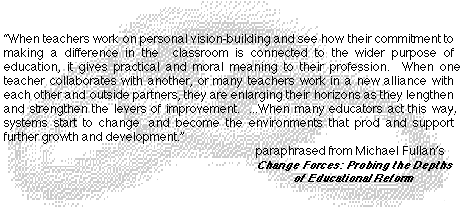Staff Development
"Where do we begin?"
Prerequisites:
- Clear mind
- An inquisitive mind
- Good connection
- Supportive team
- Basic browser skills
- Working knowledge of electronic discussion tools
- Concern about the issue
Purpose:
- To implement the role of teacher as facilitator, guide, co-learner and co-investigator
- At the beginning of this lesson you should know your team of participants well enough to assess their ability as change agents for their specific circumstances. Participants who are district level employees will need to base their plans on district needs, whereas the teacher who will be responsible at the building level will have different needs. The Action Plan Rubric is provided for assessing their plans. Remember, all participants will need to turn in an action plan of some type. You will be the judge if it needs to be a building-level or district-level plan. Districts who wish to work on a more comprehensive plan, which goes beyond the scope of LInC Online, may refer to the Reading Resources page and/or the reference page for staff development. This page is not linked to the Staff Development home page listing and its use is up to the discretion of the facilitator.
-
- "The very mention of staff development conveys the impression of something done to teachers and to students rather than something done by teachers for students" (National Staff Development Council and National Association of Secondary School Principals Study Guide 1995). It is imperative to look at where current staff development is, and then take a look at what the future looks like in the emergence of professional development.
- A bibliography of staff development-related
readings is available as an optional resource to help you
explore this critical issue in education today.
- These articles have been judged to provide the reader with the most information in a limited time frame. Educational technology innovation is more than skill building. The groundwork for the staff development that you accomplish may set the tone for educational reform in your school or district. The goal of this lesson is for you to become more knowledgeable to accomplish effective facilitation in engaged learning for your school or district.
- Below are key questions that we have found to be very useful in this planning process. Post to the discussion tool your reflections on these questions and what you have read as assigned by your facilitator. Be ready to discuss possible "pot holes" and compensatory strategies for your specific road to technology innovation during your weekly chat.
As you start working on your staff development plan, consider the following questions:
- How does your school/district currently provide staff development?
- How does your school's current program support its mission or vision statement?
- Who is in charge of implementing staff development for your school/district?
- Who are the key people in your school/district that must buy-in to a plan?
- What do you foresee as obstacles to the integration of technology-supported engaged learning in your school/district?
- What were your best and worst past experiences with participating in or conducting staff development? Why?
- What are your questions and concerns about staff development in general, and about creating an action plan for your school/district with respect to integrating technology-supported engaged learning into the curriculum?
- How will you help others in your school/district to develop expertise in engaged learning, Internet skills, and in integrating these with the curriculum?
This week's assignment is to start teachers upon the reflection process about where their district or school is currently, where they want to go, what they need to know and do to get there, and how they will know when they have arrived. You will be called upon to question, probe for clarity by restating their questions, and question again. Suggest that they make notes to start building an outline to their plan. If there is time, urge participants to each read different articles other than the selected ones and share with their colleagues in the discussion tool. You might suggest that you divide up the remaining articles or select several more in the area of interest that are relevant, jigsaw, and share either by discussion tool or within your chat time.
(![]() ) Make sure each individual
participant takes a look a the rubric you will use for their evaluation.
You will need to refer to the rubric when providing guidance and
direction for the feedback of their plans.
) Make sure each individual
participant takes a look a the rubric you will use for their evaluation.
You will need to refer to the rubric when providing guidance and
direction for the feedback of their plans.
![]()
What to send: Reflections on the questions and responses to other reflections.
Where to send: Post your responses as indicated by your facilitator or as indicated on your assignment sheet.
